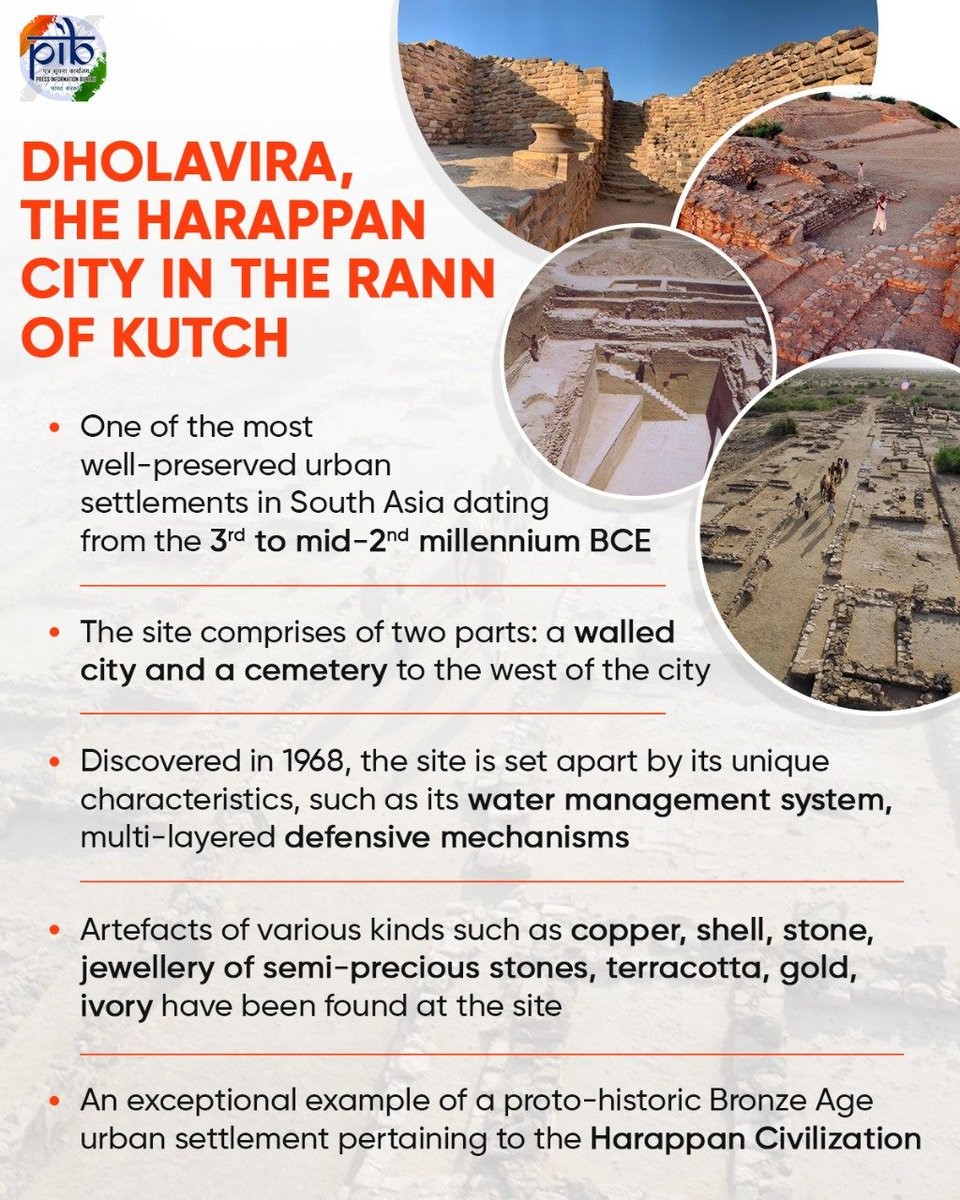[ad_1]

Context:
The United Nations Educational, Scientific and Cultural Organization (UNESCO), recently, inscribed the 13th-century Ramappa in Palampet, Telangana a ‘World Heritage Site’.
Dholavira, the archaeological site of a Harappan-era city, received the UNESCO world heritage site tag.
While Dholavira became the fourth site from Gujarat and 40th from India to make the list, it is the first site of the ancient Indus Valley Civilisation (IVC) in India to get the tag.
About UNESCO World Heritage Sites:
- A World Heritage Site is a landmark or area, selected by the UN Educational, Scientific and Cultural Organization (UNESCO) for having cultural, historical, scientific or other forms of significance, which is legally protected by international treaties.
- The sites are judged to be important for the collective and preservative interests of humanity.
- A WHS must be an already-classified landmark, unique in some respect as a geographically and historically identifiable place having special cultural or physical significance.
- It may signify a remarkable accomplishment of humanity, and serve as evidence of our intellectual history on the planet.
- The list is maintained by the international World Heritage Programme administered by the UNESCO World Heritage Committee, composed of 21 UNESCO member states which are elected by the General Assembly.
- Each World Heritage Site remains part of the legal territory of the state wherein the site is located and UNESCO considers it in the interest of the international community to preserve each site.
- To be selected, a World Heritage Site must be an already classified landmark, unique in some respect as a geographically and historically identifiable place having special cultural or physical significance.
About History of Ramappa Temple:
- The iconic Ramappa Temple showcases the outstanding craftsmanship of great Kakatiya dynasty.
- Rudreshwara (Ramappa) Temple is a masterpiece of Kakatiyan-era architecture, employing engineering innovation in the form of floating bricks, sand-box foundations, selection of building material and masterful stone sculpting.
- The Ramalingeswara temple, also known as the Ramappa temple, was named after its chief sculptor Ramappa. It is one of the very few temples in the world named after its sculptor.
- According to Telangana Tourism, “The mediaeval Deccan temple dates back to 1213 AD and was built under the patronage of the Kakatiya ruler Kakati Ganapathi Deva under the authority of his Chief Commander Rudra Samani at Ranakude in the Atukuru province.”
- Aside from its architecture and elaborate carvings on the temple’s walls, pillars, and ceilings, the most notable feature of this temple is that it was constructed using bricks that are so light that they can float on water.
- The temple is built on a 6-foot-high platform with a cruciform plan in a valley and took nearly 40 years to complete.
- The chamber of the temple is crowned by a ‘shikharam’ and surrounded by ‘pradakshinapatha’.
About Dholavira site and Distinct features:
- The IVC acropolis is located on a hillock near present-day Dholavira village in Kutch district, from which it gets its name. It was discovered in 1968 by archaeologist Jagat Pati Joshi.
- The site’s excavation between 1990 and 2005 under the supervision of archaeologist uncovered the ancient city, which was a commercial and manufacturing hub for about 1,500 years before its decline and eventual ruin in 1500 BC.
- After Mohen-jo-Daro, Ganweriwala and Harappa in Pakistan and Rakhigarhi in Haryana of India, Dholavira is the fifth largest metropolis of IVC.
- The site has a fortified citadel, a middle town and a lower town with walls made of sandstone or limestone instead of mud bricks in many other Harappan sites.
- Archaeologist cites a cascading series of water reservoirs, outer fortification, two multi-purpose grounds, one of which was used for festivities and as a marketplace, nine gates with unique designs, and funerary architecture featuring tumulus, hemispherical structures like the Buddhist Stupas, as some of the unique features of the Dholavira site.
How does this program help the listed site and the country?
- When a site is inscribed on the World Heritage List, the resulting prestige often helps raise awareness among citizens and governments for heritage preservation.
- Greater awareness leads to a general rise in the level of the protection and conservation given to heritage properties.
- A country may also receive financial assistance and expert advice from the World Heritage Committee to support activities for the preservation of its sites.
- The site will also get immediate international recognition which boosts the tourism of the country.
Conclusion:
In its release, UNESCO termed these sites in India as the most remarkable and well-preserved urban settlements in South Asia dating from the 3rd to mid-2nd millennium BCE (Before Common Era).
Noting that the cultural heritage and the natural heritage are increasingly threatened with destruction not only by the traditional causes of decay, but also by changing social and economic conditions which aggravate the situation with even more formidable phenomena of damage or destruction.
Considering that, in view of the magnitude and gravity of the new dangers threatening them, it is incumbent on the international community as a whole to participate in the protection of the cultural and natural heritage of outstanding universal value, by the granting of collective assistance which, although not taking the place of action by the State concerned, will serve as an efficient complement thereto.
Considering that it is essential for this purpose to adopt new provisions in the form of a convention establishing an effective system of collective protection of the cultural and natural heritage of outstanding universal value, organized on a permanent basis and in accordance with modern scientific methods.
[ad_2]

